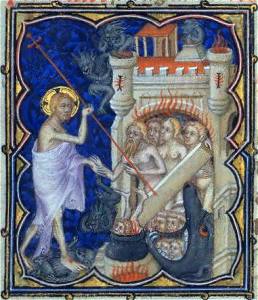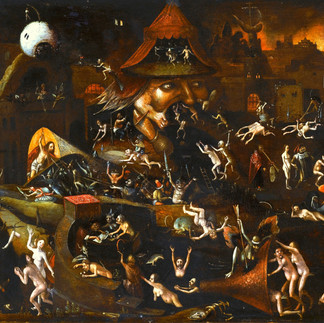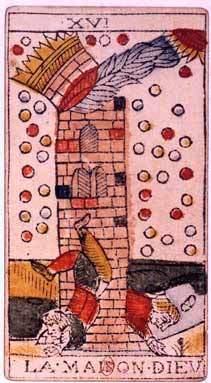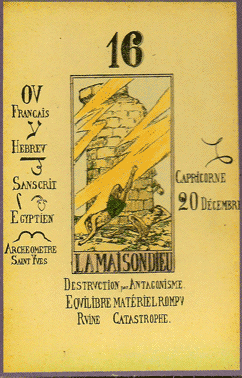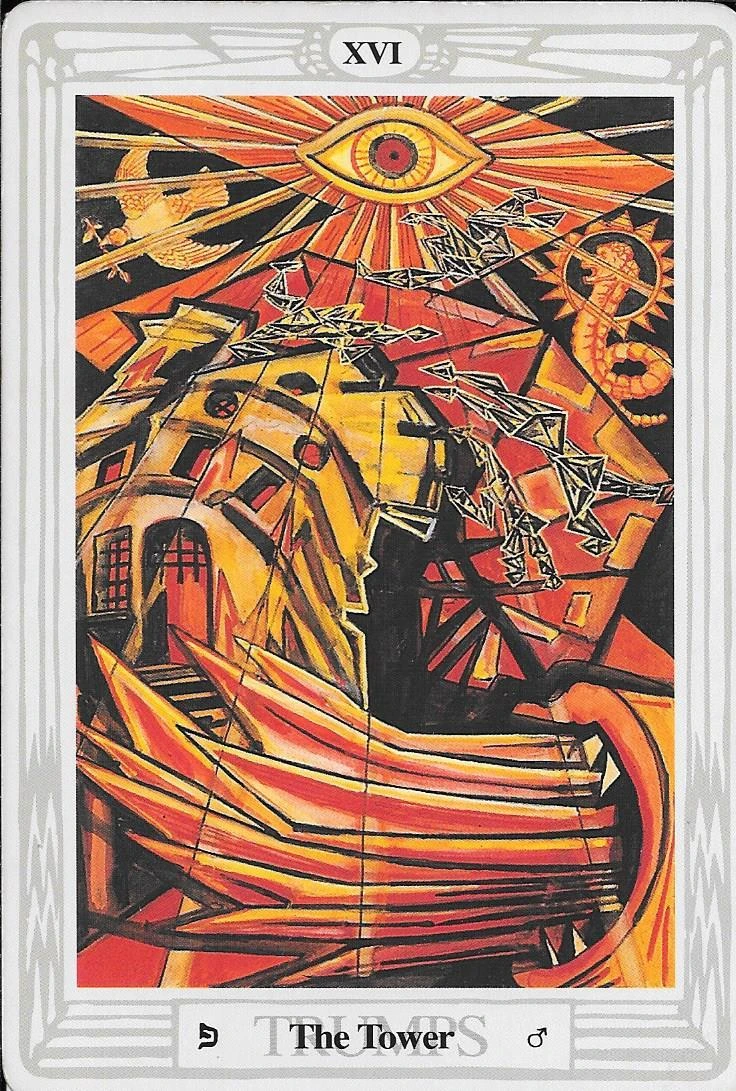Tarot Deep Dive - The Tower
- Dustin
- Feb 19, 2023
- 6 min read
Every card represents an aspect of humanity that has echoed through time. In this series we are going to dive into the history of the imagery found within the tarot, the meaning of the cards and how that meaning changed over time, and the symbols present within the images of what is arguably the most well-known tarot deck of all time - the Rider-Waite (Smith) Tarot Deck. So, grab your favorite RWS deck, a cup of tea or coffee, and join me live on Sunday mornings over on YouTube as we Deep Dive into each one of the 21 Major Arcana cards continuing now with the crushing Tower, or House of God.
The Tower, The House of God, Lightning

Towers have been used by mankind all through out history and even date back into prehistory with the oldest known examples being the circular towers found at Jericho which date to around 8000 B.C. The tower has taken on many forms and chapes from the ziggurats of Sumer, the classical Tower of Babel, the Leaning Tower of Pisa, or even the Eifel Tower in Paris. It was the Romans and Phoenicians who popularized the style and use of the tower through history - that of a fortified location or lookout. Early towers were often built alone, but later in history became key components in various architectural formats from castles and walls to cathedral bell towers. The Tower, among readers and enthusiasts, is considered a bad omen. The image of the solid fortress tower being destroyed by a divine act, crumbling it down to it's very foundations is a allegory for revelation, loss of control, sudden destructive change, and a good old fashioned ego check. Historically the image we often associate with this card in many modern day decks can be linked directly to the Abrahamic traditions and the book of Genesis. However many other theories do exist that that correlate the iconography and symbolism of this arcana to larger symbolic and art historical traditions particularly in reference to some of the historical variants of the card that we will explore some later on.

The story of the Tower of Babel comes from Genesis 11:1-9. As the story goes, mankind grew united in their egos and hubris and decided to build a tower directly to heaven. To prevent this from happening God confounds mankind by making them suddenly speak different languages and scattering mankind to all the corners of the globe. Interestingly the bible actually never actually names the tower and city in Genesis. According to some biblical scholars, the tower and city received the name "Babel" from the Hebrew verb בָּלַל (bālal), meaning to scramble or to confuse. This is interesting also where we get the idiom Babel from in the English language. This biblical story, as with many others, was often depicted in art in the middle ages and early renaissance when literacy was extremely low and most religious serves were not conducted in the local vernacular. As with many of the the other allegorical major arcana cards the importance of this story and it's universality in the time period lent itself well to it's inclusion in the major arcana of the playing cards that developed into what we know as the Tarot today.
Visual Evolution


In some earlier decks we do have some variations to the Tower of Babel allegorical representation that will explore first. In the minchiate (pictured to the right) we have a image of nude woman running out of a burning tower gateway. In the Tarot of Paris (pictured to the left) we find a depiction of a battle good versus evil - the exact depiction is somewhat debated but is though to either be demons fighting the damned or a depiction of hell itself. Some of these alternative depictions we find in extant historical decks have led academics to compare the imagery of Hell Mouths (which we discussed in our Deep Dive on The Devil), and one of the major art historical allegories - 'The Harrowing of Hell'. This was a depiction of Jesus descending into Hell on Holy Saturday to free the souls trapped within, including Adam and Eve. Interestingly in many art historical depictions of this allegory the setting is that of a tower like structure on fire and crumbling to the ground representing salvation - an interesting distinction from the former.
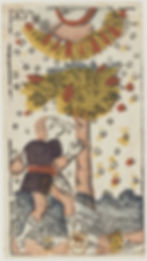
Similarly, we have decks such as the Viéville Tarot that depart entirely from the two aforementioned depictions. In this example we see a figure standing before a tree being struck by fire and lightning - another example of something solid and strong being torn down before our eyes outside of control. And even in some decks we see depictions of the fall of Adem and Even and the Garden of Eden. All these stories relate back to the concept of Hubris.
Like The Devil, the Visconti Sforza examples are missing The Tower but we can get a good sense from the Charles VI deck of what it may have appeared like. As we can see from the examples below the image of the Tower card remains pretty consistent through time with visualization closely linked to the allegory of The Tower of Babel which we still find to this day in many modern depictions of the card. Crowley interestingly combines the the above allegories into one including a Hell Mouth which breaths out fire on the tower from below. While the Dove of God flies down from above combining several Abrahamic allegories into one esoterically and symbolically rich depiction.
Evolution of Meaning
De Mellet (1781): The Tower. The House of God. The earthly paradise from which man and woman are expelled by a comet and hailstorm, or fiery sword.
Levi (1855): The Hebrew letter Ayin. Tower. The Haven of the Moon, alteration, subversion, changes, failings.
Mathers (1888): The Lightning-Struck Tower. Ruin, disruption, loss, bankruptcy.
Golden Dawn (1896): Lord of the Hosts of the Mighty. Tower. Ambition, fighting, courage. In certain combinations (or reversed), destruction, danger, fall.
Waite (1910): The Tower. Misery, indigence, adversity, calamity, disgrace, deception, unforeseen catastrophe.
Crowley (1944): This card is attributed to the letter Pe', which means a mouth; it refers to the planet Mars. In its simplest interpretation it refers to the manifestation of cosmic energy in its grossest form. The picture shows the destruction of existing material by fire. It may be taken as the preface to Atu XX, the Last Judgment, i.e., the Coming of a New Aeon. This being so, it seems to indicate the quintessential quality of the Lord of the Aeon2. At the bottom part of the card, therefore, is shown the destruction of the old established Aeon by lightning, flames, engines of war. In the right-hand corner are the jaws of Dis, belching flame at the roo~ of the structure. Falling from the tower are broken figures of the garrison. It will be noticed that they have lost their human shape.
The Symbols

Black Sky
Black is often associated with darkness and mourning. A black sky without stars represents the darkness engulfing the Tower and its inhabitants.

The Crown Thought to be a representation of Kether. A reminder to remember that there is a higher purpose behind everything and no matter how high you may raise on this world it can all be taken away in an instant.

Tower Struck by Lightning
Although Waite gives us no direct information about why he chose to depict this card so traditionally - we know from art history that the tower here represents the Tower of Babel and symbolically represents the ideas of mans control over nature and egotism and arroggance. The lightning destroying it is the hand of God (a reference to Zues perhaps?) giving mankind an ego check.

The Figures
The two figures, one crowned, are thought to represent King Nebuchadnezzar and his vizier. Waite says that they represent "literal word made void" and "its (the word) false interpretation." Indirectly referencing the allegory of Babel and god removing mankind's ability to communicate.

Golden Drops
These marks are thought by many to represent the letter Yod. 12 and 10 on either side of the tower - a reference to the Tree of Life.

Three Windows The Tower here, and historically has three windows. Representing the Holy Trinity and the the sephirot at the top of the tree of life.
As always be sure to check out our live discussion on this very topic over on YouTube:
References
Barbier, L. (2021). Tarot and divination cards: A visual archive. Cernunnos, 2021.
Butler, B. Dictionary of the Tarot. New York: Schocken Books, 1986.
Chang, T. Susan. Tarot Correspondences: Ancient Secrets for Everyday Readers. Llewellyn Pulbications, 2018.
Crowley, Aleister (aleister Crowley). Book of Thoth - (Egyptian Tarot). Red Wheel/Weiser, 2017.
Dean, Liz. The Ultimate Guide to Tarot: a Beginners Guide to the Cards, Spreads, and Revealing the Mystery of the Tarot. Fair Winds Press, 2015.
Decker, Ronald; Dummett, Michael. A History of the Occult Tarot. London: Duckworth, 2019.
Fiebig, Johannes, and Evelin Burger. The Ultimate Guide to the Rider Waite Tarot. Llewellyn, 2013.
Katz, Marcus. Secrets of the Waite-Smith Tarot: the True Story of the Worlds Most Popular Tarot: with Previously Unseen Photography & Text from Waite & Smith. Llewellyn Publications, 2015.
Kelly, Henry Ansgar, Satan: A Biography, Cambridge, England: Cambridge University Press, 2006.
Place, R. M. The fool's journey: The history, art, & symbolism of the tarot. York, 2010.
Waite, A. E. Pictorial Key to the Tarot. Dover Publications Inc, 2005.
Wen, Benebell. Holistic Tarot. North Atlantic Books, 2015.




